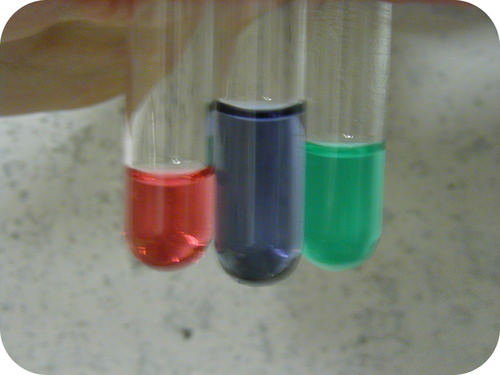19.1 逆反应
章节大纲
-
How do you change the color of a solution?
::您如何改变解决方案的颜色 ?A solution of cobalt chloride in water is pink due to the presence of the solvated Co 2+ . If sufficient HCl is added, the solution turns blue as the CoCl 4 2- ion forms. The reaction can be shifted back to the pink form if more water is added to the solution.
::在水中氯化钴的溶液是粉红色的,因为存在溶解的CO2+。如果添加足够的 HCl,溶液会变成蓝色的CoCl42离子形式。如果溶液中添加更多的水,反应可以回到粉红色形式。Reversible Reactions
::可逆反应反应Up until this point, we have written the equations for in a way that would seem to indicate that all reactions proceed completely until all the reactants have been converted into products. In reality, a great many chemical reactions do not proceed entirely to completion. A reversible reaction is a reaction in which the conversion of reactants to products and the conversion of products to reactants occur simultaneously. One example of a reversible reaction is the reaction of hydrogen and iodine vapor to from hydrogen iodide. The forward and reverse reactions can be written as follows.
::在这一点之前,我们已经写出各种方程式,以便显示所有反应完全进行,直到所有反应器都转化为产品。事实上,许多化学反应并没有完全完成。一种可逆反应是反应器转换成产品和产品转换成反应器同时发生的反应。一种可逆反应的一个例子是氢和碘蒸气从碘化氢反应成碘化氢。前向反应和反向反应可以写如下。
::前方反应:H2(g)+I2(g)%2HI(g)反向反应:2HI(g)+H2(g)+I2(g)In the forward reaction, hydrogen and iodine combine to form hydrogen iodide. In the reverse reaction, hydrogen iodide decomposes back into hydrogen and iodine. The two reactions can be combined into one equation by the use of a double arrow.
::在前方反应中,氢和碘结合成碘氢,在反向反应中,碘氢分解回氢和碘。两种反应可以通过使用双箭将两者合并成一个方程式。
::H2(g) +I2(g) 2HI(g)The double arrow is the indication that the reaction is reversible.
::双箭表示反应是可逆的。When hydrogen and iodine gases are mixed in a sealed container, they begin to react and form hydrogen iodide. At first, only the forward reaction occurs because no HI is present. As the forward reaction proceeds, it begins to slow down as the of the H 2 and the I 2 decrease. As soon as some HI has formed, it begins to decompose back into H 2 and I 2 . The rate of the reverse reaction starts out slow because the concentration of HI is low. Gradually, the rate of the forward reaction decreases while the rate of the reverse reaction increases. Eventually the rate of combination of H 2 and I 2 to produce HI becomes equal to the rate of decomposition of HI into H 2 and I 2 . When the rates of the forward and reverse reactions have become equal to one another, the reaction has achieved a state of balance.
::当氢和碘气体混合在密封容器中时,它们开始反应并形成碘化氢。首先,只有前方反应才会发生,因为没有HI的存在。随着前方反应的继续,随着H2和I2的减少,它开始减慢。一旦一些HI形成,它开始分解回H2和I2,反向反应的速度开始缓慢,因为HI的浓度较低。逐渐,前方反应的速度下降,反向反应的速度上升。最终,H2和I2生产HI的结合速度与H2和I2的分解速度相同。当前方和反向反应的速度变得等同时,这种反应的速度达到了平衡状态。Summary
::摘要-
A reversible reaction is defined.
::定义了可逆反应。
Review
::回顾-
Do all chemical reactions proceed to completion?
::所有化学反应是否都进入完成阶段? -
Why is the reaction given above considered a reversible reaction?
::为什么上述反应被视为可逆反应? -
How do we designate a reversible reaction?
::我们如何指定可逆反应?
-
A reversible reaction is defined.
